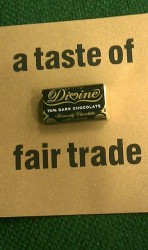About 80 people attended the first showing of the documentary “The Dark Side of Chocolate” at the Fuller Seminary’s Travis Auditorium in Pasadena, Calif. during Fair Trade month (October), where it made people see what the power of their dollar has when purchasing certain chocolates.
By JULIO A. CRUZEL NUEVO SOL
The viewing of “The Dark Side of Chocolate” that was showed at the Fuller’s Seminary Auditorium in Pasadena on Oct. 15 was not only part of an activity during Fair Trade month but it was a reality check for people to be aware of the inhumane actions occurring in the making of a bar of chocolate.

Fair Trade chocolate practices humane labor with its producers and protects their rights. Photo by Julio A. Cruz / ENS
Facts are shown in the documentary that most people do not know about when it comes to the real story and work that is behind a Hershey’s bar, for example.
The true story is not only in the film itself but from what people had to say or reacted to after watching it.
“It was really sad to see that stuff going on nowadays,” said Melissa Campos Avelar, an immigration attorney, regarding the film.
Here a some of the facts that make it appalling:
According to the European Fair Trade Association, farmers get barely 5 percent of the profit from chocolate, whereas trading organizations and the chocolate industry receive about 70 percent. This means that producers get only 5 cents from every dollar spent on chocolate, while the companies get 70 cents, 14 times more.
Global Exchange, a nonprofit organization and educational and action resource center that is an alternative economics of quality centered upon protecting international human rights, reports that the US State Department’s year 2000 Human Rights Report acknowledged “that some 15,000 children between the ages of 9 and 12 have been sold into forced labor on cotton, coffee and cocoa plantations in northern Ivory Coast in recent years.”
The film does report that 42 percent of cocoa production for the world comes from this West African country. Certain chocolate farms like the ones Nestle works from have used pesticides in its production for the past 20-30 years and Nestle has been in countries like Ivory Coast for the past 50 years.
“I loved how it showed that emotion that everyone experiences,” said Sarah Shick from Just One, a nonprofit organization that helps fight poverty and trafficking. “Like that man that worked for United Nations – Child Labor Unions saying that after 30 years of working it is still overwhelming to him and heart breaking.”
Aside from the horrific practices that chocolate corporations work on, such as the use of children who have been trafficked, some even as young as seven-years-old, and promising them a good pay, there is an alternative way to feeling good about the chocolate that we consume.
“I try to be more conscious when buying chocolate,” Avelar said.
Chocolate is a big consumption in the United States where 46% of Americans say they can’t live without chocolate and in 2000, they consumed 3.3 billion pounds of it, according to SERRV, a nonprofit organization that works with and supports artisans and farmers across the world.
One of the main purposes to showing the documentary is to have people learn about the problem and become active on this issue, like Fair Trade Pasadena member Rachel Badillo says, “we have to create a demand.”
Badillo suggests that people could or/and should write to a company like Nestle and send them a wrapper of a Fair Trade chocolate bar, saying that people prefer this type of “ just” chocolate over theirs.
“Hopefully this touches many people and beyond,” Badillo said about what people should take out of the film. “Get involved and spread the word, hopefully join our Facebook [page]…I think it’s a very good start.”
Tags: Divine Chocolate European Fair Trade Association Fair Trade month Fair Trade Pasadena Global Exchange Hershey's Ivory Coast Just One Nestle SERRV The Dark Side of Chocolate












